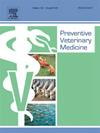Impact of dairy farming extension programs on smallholder livestock keepers’ welfare among Maasai communities in Arusha, Tanzania
IF 2.2
2区 农林科学
Q1 VETERINARY SCIENCES
引用次数: 0
Abstract
Despite the crucial role of livestock farming in enhancing livelihoods, production levels remain notably low, particularly in nomadic societies, resulting in diminished welfare among Africa's most renowned communities, the Maasai. To improve the welfare of smallholder livestock keepers, dairy farming extension programs are essential, as they stimulate knowledge transfer, resource accessibility, and adoption of best practices. This study employed a quasi-experimental research design, engaging a total of 431 livestock keepers, comprising 221 treated participants and 210 control group members from the Engaruka, Lepurko, and Selela wards in Monduli District, Arusha, Tanzania. Utilizing the Double Hurdle model and Propensity Score Matching (PSM), the study estimated the determinants of participation and the impacts of these interventions on welfare. The results revealed that demographic factors, social capital, and educational attainment significantly influenced participation rates in dairy farming extension programs. Additionally, the Average Treatment on the Treated (ATT) analysis showed that participation led to an increase of 5.751 liters per day in milk production and a monthly income boost of 11,670 TSHS. However, mean income differences showed that participants earned 55,010 TSHS more than non-participants. This suggests that while extension programs contribute to higher incomes, pre-existing differences such as access to resources, experience, and herd size also contribute to this disparity. These findings informs that effective extension services can markedly improve the welfare of Maasai livestock keepers by providing critical training and resources that enable higher productivity and economic resilience. By fostering social networks, facilitating market access, and enhancing knowledge among farmers, extension programs play a vital role in empowering these communities. Therefore, targeted strategies that promote inclusivity, improve access to resources, and incorporate educational initiatives are recommended to maximize the benefits of these programs.
奶牛养殖推广项目对坦桑尼亚阿鲁沙马赛社区小农牲畜饲养者福利的影响
尽管畜牧业在改善生计方面发挥着至关重要的作用,但生产水平仍然很低,特别是在游牧社会,导致非洲最著名的社区马赛人的福利下降。为了提高小农牲畜饲养者的福利,奶牛养殖推广项目至关重要,因为它们可以促进知识转移、资源可及性和最佳做法的采用。本研究采用准实验研究设计,共有431名牲畜饲养者参与,其中包括221名接受治疗的参与者和210名对照组成员,他们来自坦桑尼亚阿鲁沙Monduli区的Engaruka、Lepurko和Selela病房。利用双重障碍模型和倾向得分匹配(PSM),研究估计了参与的决定因素以及这些干预措施对福利的影响。结果显示,人口因素、社会资本和受教育程度显著影响奶牛养殖推广计划的参与率。此外,对被处理者的平均处理(ATT)分析显示,参与导致牛奶产量每天增加5.751升,月收入增加11,670 TSHS。然而,平均收入差异显示,参与者比非参与者多赚55,010个TSHS。这表明,虽然推广项目有助于提高收入,但已有的差异(如获取资源、经验和畜群规模)也导致了这种差距。这些发现表明,有效的推广服务可以通过提供关键的培训和资源来提高生产力和经济复原力,从而显著改善马赛牲畜饲养者的福利。通过培育社会网络、促进市场准入和提高农民的知识水平,推广项目在增强这些社区的权能方面发挥着至关重要的作用。因此,建议采取有针对性的战略,促进包容性,改善资源获取,并纳入教育举措,以最大限度地发挥这些项目的效益。
本文章由计算机程序翻译,如有差异,请以英文原文为准。
求助全文
约1分钟内获得全文
求助全文
来源期刊

Preventive veterinary medicine
农林科学-兽医学
CiteScore
5.60
自引率
7.70%
发文量
184
审稿时长
3 months
期刊介绍:
Preventive Veterinary Medicine is one of the leading international resources for scientific reports on animal health programs and preventive veterinary medicine. The journal follows the guidelines for standardizing and strengthening the reporting of biomedical research which are available from the CONSORT, MOOSE, PRISMA, REFLECT, STARD, and STROBE statements. The journal focuses on:
Epidemiology of health events relevant to domestic and wild animals;
Economic impacts of epidemic and endemic animal and zoonotic diseases;
Latest methods and approaches in veterinary epidemiology;
Disease and infection control or eradication measures;
The "One Health" concept and the relationships between veterinary medicine, human health, animal-production systems, and the environment;
Development of new techniques in surveillance systems and diagnosis;
Evaluation and control of diseases in animal populations.
 求助内容:
求助内容: 应助结果提醒方式:
应助结果提醒方式:


